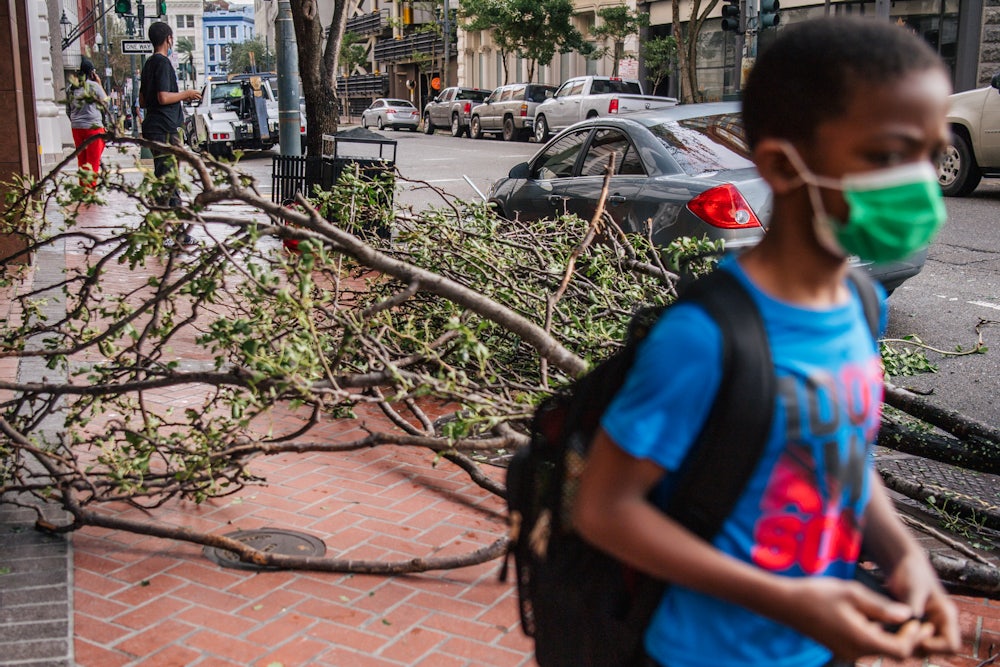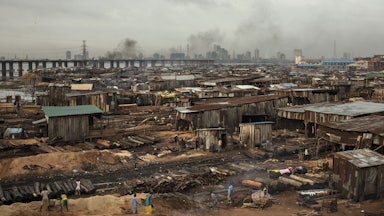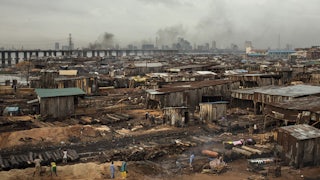Exactly 16 years after Hurricane Katrina devastated New Orleans, Hurricane Ida struck Louisiana on Sunday, flooding towns and knocking out power for entire parishes. The New Orleans levee system erected in the wake of Katrina’s catastrophic failures held. But there were two notable differences between the storms. First was Ida’s rapid intensification as she sped over climate change–warmed Gulf waters. And second, she struck a region already pushed to its limits by Covid-19. In this sense, Hurricane Ida may have been the first storm of the new normal: an era in which overlapping crises make natural disasters much, much harder to fight.
Thanks most likely to global warming, Louisiana officials had very little time to prepare. In just six hours on Saturday night, due to unusually warm waters in the Gulf of Mexico, the hurricane’s speed accelerated from 85 to 150 miles an hour, morphing into meteorologists’ worst-case scenario. Even in a time of extreme storms, that’s mind-boggling. In contrast, Hurricane Katrina passed over cooler waters and slowed her speed.
Ida slammed into a region that has suffered a massive spike in Covid-19 cases in the past few weeks. When the hurricane ripped off the roofs, blew out the windows, and flooded the hallways of coastal hospitals Sunday night, patients were still inside; it’s difficult to evacuate when every hospital within hundreds of miles is full. Now millions of people in Louisiana are left without electricity or running water, simmering in 80-degree heat, as Ida moves on to threaten other hard-hit states with floods—all while the pandemic shows no sign of slowing down. Those who are evacuated or forced to leave their damaged homes may also be at higher risk of getting or passing on the virus when they travel and stay with others, especially in crowded conditions.
Climate change is replete with what researchers call “compound risks” and military brass call “threat multipliers.” Pandemics are a threat multiplier. Epidemics will become more common as the environment changes and more viruses spill over into humans. Harsher conditions make these health crises worse. While the American South is inundated with water, the West has too little and burns red with wildfires, sparking its own evacuations. Beyond the health implications of evacuations, wildfire smoke itself may have led to thousands of Covid cases and deaths in the West last year, new research shows.
And pandemics can complicate our response to climate change and other environmental crises, by dominating resources and taking our attention away from the next catastrophe hovering on the horizon. In fact, they could be thought of as a type of feedback loop—like how melting sea ice leads to warmer temperatures, which, in turn, melt more sea ice. Orlando, Florida, announced in August, for example, that it would cut water resources in half because the liquid oxygen used to treat water is being diverted to hospitals running out of oxygen for Covid patients. If residents couldn’t cut water use, officials warned, the city might be forced into a boil water advisory—a staggering step that could in turn exacerbate the public health crisis. It’s hard to wash your hands when there’s no clean water at home.
“Our economies, our health, and biodiversity and ecosystems are intimately interlinked, and enormous shocks to any one of those systems tend to cascade and damage others,” Dr. Christopher Trisos, director of the Climate Risk Lab and senior researcher at the University of Cape Town, told me. “If we do suffer repeated health shocks that damage economies, that leaves societies less well resourced to tackle the climate crisis.”
There are ways to address the threat posed by interlocking pandemics and environmental crises. But they require a shift in policy paradigms. “Addressing both kinds of problems requires a global approach,” Scott Barrett, professor at Columbia University’ s School of International and Public Affairs, told me. So far, we haven’t been very good at that. “Our first instincts are much more in the direction of nationalism and sovereignty than they are about collaboration, coordination, and cooperation.”
The Covid-19 pandemic offers unusually apt examples of where national governments failed at global thinking, to the detriment of both their own citizens and those in other countries. The development of the vaccines is one such example. “It’s remarkable that so many effective vaccines were developed so quickly,” Barrett said. Yet the massive inequities in global distribution persist, in part because of the specialized knowledge needed to manufacture mRNA vaccines and the cold chain needed for highly effective vaccines. “If we had a vaccine that was a little less effective but was easier to produce, using existing production technologies in developing countries, that would have been helpful,” Barrett said—which is still an option for some of the vaccines in the pipeline. With a rapid global vaccine rollout, the evolution of the virus might have been slowed, forestalling the arrival of new variants like the delta variant, which has been incredibly destructive in countries like India and Indonesia, as well as in U.S. states like Louisiana and Florida.
This example ought to offer lessons for how we develop and deploy climate technologies: In this new era, inequity itself represents a serious global threat. “Covid and climate are both just profound case studies of the structural factors at play that are having major impacts on people’s health,” Dr. Gaurab Basu, a health equity fellow for Harvard’s C-CHANGE program and co-director of the Center for Health Equity Education and Advocacy at Cambridge Health Alliance, told me. “They both cast a die on the fault lines of inequity in our society, and they speak to the need for us to do this broader, more structural work to make sure people are healthy.”
While “we can feel a little overwhelmed” by these compounding crises, there is an upside, Basu added. “If we have appropriate, aggressive, bold policy that can address these crises, we can be solving a lot of problems at once.”
“There can be a virtuous circle,” Trisos said. “Potential climate change adaptation actions can also be pandemic adaptation.” Take health care, for instance: If people have access to universal health care, they are better able to withstand the stresses of, say, climate disasters or pandemics, resulting in better outcomes across the board. That’s particularly true for those who live on the edge of personal disaster when natural disasters strike. When the most vulnerable have access to care, a health shock, “whether it’s from a pandemic or from a climate disaster, like a flood or a cyclone or drought or the spread of infectious disease because of changing geographies,” isn’t nearly as devastating, Trisos said.
Similarly, social safety nets can support people who may be temporarily out of work because of changes to the energy industry or droughts in agricultural landscapes. “Those same safety nets can help with pandemic prevention in terms of allowing people to stay home from work, from high-risk jobs,” he said.
Pandemics don’t just have to be negative feedback loops. They can also serve as positive tipping points, leading us to make changes that address health and climate crises at the same time, because they are so deeply intertwined. Restoring ecosystems, keeping carbon emissions in the ground and out of the air, improving water and food security, investing in social safety nets and universal health care, designing better early warning systems for extreme events, improving building resilience—it all helps the health of humans and the planet.
Policymakers also need to make sure emergency measures to respond to one crisis don’t exacerbate another. A good example of where countries failed on that last year was in stimulus spending, meant to forestall disaster as Covid shutdowns tanked the global economy. Roughly $250 billion of Covid stimulus investments in the energy sector in G20 countries have gone toward fossil fuels rather than cleaner energy sources, Trisos pointed out. Fossil fuels not only accelerate the climate crisis and its attendant natural disasters, but they contribute to air pollution in ways that make people who contract Covid more likely to experience extreme symptoms, wind up in the hospital, and die. Investing in greener energy sources, on the other hand, could turn the Covid crisis into a positive feedback loop, inching toward a safer future.
Sometimes it seems like the whole world is crumbling—burning to the ground or being washed away, while a deadly virus continues sweeping through our communities and threatening the lives of those we love. But when crises converge, fixing one can help fix the other. Politicians could choose to make both crises much worse. Or they could approach policymaking with a wide-ranging, global view, realizing that catastrophes, and countries’ response to them, never stand alone.








